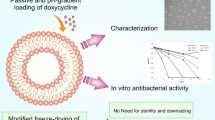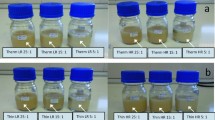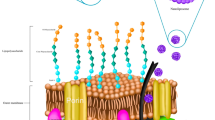Abstract
Piperacillin (Pip) is a broad spectrum β-lactam against most Gram-positive and Gram-negative aerobic and anaerobic bacteria. However, bacterial resistance restricts its benefits for the treatment of infectious diseases. Recently, nanoliposomal systems have been investigated as encouraging strategies to address this issue owing to their immense potential. We aimed to encapsulate Pip in liposomal nanoparticles and study their antibacterial activities in vitro against Pseudomonas aeruginosa (P. aeruginosa). Different liposomes were prepared based on the freeze-drying of a monophase solution method. Then, they were characterized in terms of size, zeta potential, polydispersity-index, and morphology. For further analysis, spectra of ATR-FTIR and XRD were taken for liposomal Pip. Encapsulation efficiency (EE) was determined via agar diffusion assay. Also, minimum inhibitory concentrations (MICs) were investigated by the standard broth macro-dilution method. The liposomes were from 100.9 to 444.13 nm with z-potential of − 30.70 to − 10.57 mV. EE of the selected formulation was 53.1%. TEM results showed that the liposomes were nanosized and almost spherical. ATR-FTIR results confirmed the full encapsulation of Pip in nanoliposomes. The X-ray pattern indicated that the liposomal Pip was amorphous. The MIC (10.6 µg/ml) of the nanoliposomal Pip against P. aeruginosa was one-half of the MIC (21.25 µg/ml) of free Pip for the same organisms. Considering four aspects (nanosized liposomes, no need for sterilization, suitable EE and enhanced antibacterial effects), this preparation method seems promising and may be used to overcome the bacterial resistance relative to Pip.





Similar content being viewed by others
References
Frieri M, Kumar K, Boutin A (2017) Antibiotic resistance. J Infect Public Health 10(4):369–378
Yılmaz Ç, Özcengiz G (2017) Antibiotics: pharmacokinetics, toxicity, resistance and multidrug efflux pumps. Biochem Pharmacol 133:43–62
Boucher HW, Talbot GH, Bradley JS, Edwards JE, Gilbert D, Rice LB, Scheld M, Spellberg B, Bartlett J (2009) Bad bugs, no drugs: no ESKAPE! An update from the infectious diseases society of America. Clin Infect Dis 48(1):1–12
Lambert P (2002) Mechanisms of antibiotic resistance in Pseudomonas aeruginosa. J R Soc Med 95(Suppl 41):22
Botelho J, Grosso F, Peixe L (2019) Antibiotic resistance in Pseudomonas aeruginosa: mechanisms, epidemiology and evolution. Drug Resist 44:100640
Abed N, Couvreur P (2014) Nanocarriers for antibiotics: a promising solution to treat intracellular bacterial infections. Int J Antimicrob Agents 43(6):485–496
Durão P, Balbontín R, Gordo I (2018) Evolutionary mechanisms shaping the maintenance of antibiotic resistance. Trends Microbiol 26(8):677–691
Gao W, Hu C-MJ, Fang RH, Zhang L (2013) Liposome-like nanostructures for drug delivery. J Mater Chem B 1(48):6569–6585
Baranwal A, Srivastava A, Kumar P, Bajpai VK, Maurya PK, Chandra P (2018) Prospects of nanostructure materials and their composites as antimicrobial agents. Front Microbiol 9:422
Huh AJ, Kwon YJ (2011) “Nanoantibiotics”: a new paradigm for treating infectious diseases using nanomaterials in the antibiotics resistant era. J Control Release 156(2):128–145
Gupta A, Mumtaz S, Li C-H, Hussain I, Rotello VM (2019) Combatting antibiotic-resistant bacteria using nanomaterials. Chem Soc Rev 48(2):415–427
de Souza ME, Verdi CM, de Andrade EN, Santos RC (2019) Antiviral and antimicrobial (antibacterial) potentiality of nano drugs. In: Applications of targeted nano drugs and delivery systems. Elsevier, Amsterdam, pp 327–342
Catania R, Maguire O, Moore C, Falcone FH, Chan W, Mantovani G, Stolnik S, Huett A (2019) Functionalised liposomal formulations for delivery of antibiotic agents. Access Microbiol 1:1A
Sercombe L, Veerati T, Moheimani F, Wu SY, Sood AK, Hua S (2015) Advances and challenges of liposome assisted drug delivery. Front Pharmacol 6:286
Pattni BS, Chupin VV, Torchilin VP (2015) New developments in liposomal drug delivery. Chem Rev 115(19):10938–10966
Blanco E, Shen H, Ferrari M (2015) Principles of nanoparticle design for overcoming biological barriers to drug delivery. Nat Biotechnol 33(9):941
Alavi M, Karimi N, Safaei M (2017) Application of various types of liposomes in drug delivery systems. Adv Pharm Bull 7(1):3
Dua J, Rana A, Bhandari A (2012) Liposome: methods of preparation and applications. Int J Pharm Stud Res 3(2):14–20
Immordino ML, Dosio F, Cattel L (2006) Stealth liposomes: review of the basic science, rationale, and clinical applications, existing and potential. Int J Nanomed 1(3):297
Tiwari G, Tiwari R, Sriwastawa B, Bhati L, Pandey S, Pandey P, Bannerjee SK (2012) Drug delivery systems: an updated review. Int J Pharm Investig 2(1):2
Rideau E, Dimova R, Schwille P, Wurm FR, Landfester K (2018) Liposomes and polymersomes: a comparative review towards cell mimicking. Chem Soc Rev 47(23):8572–8610
Hallaj-Nezhadi S, Hassan M (2015) Nanoliposome-based antibacterial drug delivery. Drug Deliv 22(5):581–589
Drulis-Kawa Z, Dorotkiewicz-Jach A (2010) Liposomes as delivery systems for antibiotics. Int J Pharm 387(1–2):187–198
Farokhzad OC, Langer R (2009) Impact of nanotechnology on drug delivery. ACS Nano 3(1):16–20
Bulbake U, Doppalapudi S, Kommineni N, Khan W (2017) Liposomal formulations in clinical use: an updated review. Pharmaceutics 9(2):12
Perry CM, Markham A (1999) Piperacillin/tazobactam. Drugs 57(5):805–843
Sweetman SC (2002) Martindale: the complete drug reference. Pharmaceutical Press, London
Nacucchio M, Bellora M, Sordelli D, D'aquino M (1985) Enhanced liposome-mediated activity of piperacillin against staphylococci. Antimicrob Agents Chemother 27(1):137–139
Liu S, Fukushima K, Venkataraman S, Hedrick JL, Yang YY (2018) Supramolecular nanofibers self-assembled from cationic small molecules derived from repurposed poly (ethylene teraphthalate) for antibiotic delivery. Nanomedicine 14(1):165–172
Li C, Deng Y (2004) A novel method for the preparation of liposomes: freeze drying of monophase solutions. J Pharm Sci 93(6):1403–1414
Qaiyumi S (2007) Antimicrobial Susceptibility Testing Protocols. In: Richard Schwalbe LS-M, and Avery C. Goodwin. (ed). CRC Press, pp 75–81
CLSI (2014) Performance Standards for Antimicrobial Susceptibility Testing Twenty-Fourth Informational Supplement; CLSI document M100–S24 Clinical and Laboratory Standards Institute. Wayne, PA, USA
Laxminarayan R, Duse A, Wattal C, Zaidi AK, Wertheim HF, Sumpradit N, Vlieghe E, Hara GL, Gould IM, Goossens H (2013) Antibiotic resistance: the need for global solutions. Lancet Infect Dis 13(12):1057–1098
Testero SA, Fisher JF, Mobashery S (2003) β-Lactam antibiotics. Burger Med Chem Drug Discov 5:257–402
Combes A, Luyt C-E, Fagon J-Y, Wolff M, Trouillet J-L, Chastre J (2006) Impact of piperacillin resistance on the outcome of Pseudomonas ventilator-associated pneumonia. Intensive Care Med 32(12):1970–1978
Trouillet J, Vuagnat A, Aa C, Kassis N, Chastre J, Gibert C (2002) Pseudomonas aeruginosa ventilator-associated pneumonia: comparison of episodes due to piperacillin-resistant versus piperacillin-susceptible organisms. Clin Infect Dis 34(8):1047–1054
Mah T-F, Pitts B, Pellock B, Walker GC, Stewart PS, O'toole GA (2003) A genetic basis for Pseudomonas aeruginosa biofilm antibiotic resistance. Nature 426(6964):306
Oliver A, Mulet X, López-Causapé C, Juan C (2015) The increasing threat of Pseudomonas aeruginosa high-risk clones. Drug Resist Updates 21:41–59
Stover CK, Pham XQ, Erwin A, Mizoguchi S, Warrener P, Hickey M, Brinkman F, Hufnagle W, Kowalik D, Lagrou M (2000) Complete genome sequence of Pseudomonas aeruginosa PAO1, an opportunistic pathogen. Nature 406(6799):959
Mainardes RM, Silva LP (2004) Drug delivery systems: past, present, and future. Curr Drug Targets 5(5):449–455
Zhang C, Zhao W, Bian C, Hou X, Deng B, McComb DW, Chen X, Dong Y (2019) Antibiotic-derived lipid nanoparticles to treat intracellular Staphylococcus aureus. ACS Appl Biomater 2(3):1270–1277
Arévalo L, Yarce C, Oñate-Garzón J, Salamanca C (2019) Decrease of antimicrobial resistance through polyelectrolyte-coated nanoliposomes loaded with β-lactam drug. Pharmaceuticals 12(1):1
Teixeira M, Sanchez-Lopez E, Espina M, Calpena A, Silva AM, Veiga F, Garcia M, Souto EB (2018) Advances in antibiotic nanotherapy: overcoming antimicrobial resistance. In: Emerging nanotechnologies in immunology. Elsevier, Amsterdam, pp 233–259
Mugabe C, Azghani AO, Omri A (2005) Liposome-mediated gentamicin delivery: development and activity against resistant strains of Pseudomonas aeruginosa isolated from cystic fibrosis patients. J Antimicrob Chemother 55(2):269–271
Budai M, Chapela P, Budai L, Wales ME, Petrikovics I, Zimmer A, Gróf P, Klebovich I, Szilasi M (2009) Liposomal oxytetracycline and doxycycline: studies on enhancement of encapsulation efficiency. Drug Discov Ther 3:1
Franklin RK, Marcus SA, Talaat AM, KuKanich BK, Sullivan R, Krugner-Higby LA, Heath TD (2015) A novel loading method for doxycycline liposomes for intracellular drug delivery: characterization of in vitro and in vivo release kinetics and efficacy in a J774A. 1. Cell line model of Mycobacterium smegmatis infection. Drug Metab Dispos 43(8):1236–1245
Pignatello R, Nicolosi D, Nicolosi VM (2011) Fusogenic liposomes as new carriers to enlarge the spectrum of action of antibiotic drugs against Gram-negative bacteria. In: Science against microbial pathogens: communicating current research and technological advances, pp 52–60
Li J, Wang X, Zhang T, Wang C, Huang Z, Luo X, Deng Y (2015) A review on phospholipids and their main applications in drug delivery systems. Asian J Pharm Sci 10(2):81–98
Heurtault B, Saulnier P, Pech B, Proust J-E, Benoit J-P (2003) Physico-chemical stability of colloidal lipid particles. Biomaterials 24(23):4283–4300
Matos C, de Castro B, Gameiro P, Lima JL, Reis S (2004) Zeta-potential measurements as a tool to quantify the effect of charged drugs on the surface potential of egg phosphatidylcholine liposomes. Langmuir 20(2):369–377
Moyá ML, López-López M, Lebrón JA, Ostos FJ, Pérez D, Camacho V, Beck I, Merino-Bohórquez V, Camean M, Madinabeitia N (2019) Preparation and characterization of new liposomes. Bactericidal activity of cefepime encapsulated into cationic liposomes. Pharmaceutics 11(2):69
Mutalik S, Salian SR, Avadhani K, Menon J, Joshi H, Hegde AR, Kumar P, Kalthur G, Adiga SK (2014) Liposome encapsulated soy lecithin and cholesterol can efficiently replace chicken egg yolk in human semen cryopreservation medium. Syst Biol Reprod Med 60(3):183–188
Yang T, Cui F-D, Choi M-K, Lin H, Chung S-J, Shim C-K, Kim D-D (2007) Liposome formulation of paclitaxel with enhanced solubility and stability. Drug Deliv 14(5):301–308
Ruozi B, Belletti D, Tombesi A, Tosi G, Bondioli L, Forni F, Vandelli MA (2011) AFM, ESEM, TEM, and CLSM in liposomal characterization: a comparative study. Int J Nanomed 6:557
Cabral E, Zollner R, Santana M (2004) Preparation and characterization of liposomes entrapping allergenic proteins. Braz J Chem Eng 21(2):137–146
Nugraheni RW, Setyawan D, Yusuf H (2017) Physical characteristics of liposomal formulation dispersed in HPMC matrix and freeze-dried using maltodextrin and mannitol as lyoprotectant. Pharm Sci 23(4):285–292
Akbari B, Tavandashti MP, Zandrahimi M (2011) Particle size characterization of nanoparticles: a practical approach. Iran J Mater Sci Eng 8(2):48–56
Bates S, Zografi G, Engers D, Morris K, Crowley K, Newman A (2006) Analysis of amorphous and nanocrystalline solids from their X-ray diffraction patterns. Pharm Res 23(10):2333–2349
Zander J, Döbbeler G, Nagel D, Maier B, Scharf C, Huseyn-Zada M, Jung J, Frey L, Vogeser M, Zoller M (2016) Piperacillin concentration in relation to therapeutic range in critically ill patients: a prospective observational study. Crit Care 20(1):79
Scheer F, Kraemer I (2013) PHC-021 pharmacokinetics of piperacillin and ciprofloxacin in critically ill patients undergoing continuous venovenous haemodialysis (CVVHD) or continuous venovenous haemodiafiltration (CVVHDF). Eur J Hosp Pharm Sci Pract 20(Suppl 1):A132–A133
Wang Q, Chao Y (2018) Multifunctional quantum dots and liposome complexes in drug delivery. J Biomed Res 32(2):91
Yang D, Pornpattananangkul D, Nakatsuji T, Chan M, Carson D, Huang C-M, Zhang L (2009) The antimicrobial activity of liposomal lauric acids against Propionibacterium acnes. Biomaterials 30(30):6035–6040
Holzschuh S, Kaeß K, Bossa GV, Decker C, Fahr A, May S (2018) Investigations of the influence of liposome composition on vesicle stability and drug transfer in human plasma: a transfer study. J Liposome Res 28(1):22–34
Mohammed A, Weston N, Coombes A, Fitzgerald M, Perrie Y (2004) Liposome formulation of poorly water soluble drugs: optimisation of drug loading and ESEM analysis of stability. Int J Pharm 285(1–2):23–34
Alhariri M, Azghani A, Omri A (2013) Liposomal antibiotics for the treatment of infectious diseases. Expert Opin Drug Deliv 10(11):1515–1532
Salem II, Flasher DL, Düzgüneş N (2005) Liposome-encapsulated antibiotics. In: Methods in enzymology, vol 391. Elsevier, Amsterdam, pp 261–291
Pinto-Alphandary H, Andremont A, Couvreur P (2000) Targeted delivery of antibiotics using liposomes and nanoparticles: research and applications. Int J Antimicrob Agents 13(3):155–168
Gonzalez GA, Xu C, Hosseinidoust Z (2019) Preserving efficacy of glycopeptide antibiotics during nano-encapsulation in liposomes. ACS Infect Dis 10:1794–1801
Author information
Authors and Affiliations
Contributions
PS: Performed some of the experiments and co-wrote the paper. TT-F: Performed experiments. MM: Designed some of the experiments. NH: performed some of the experiments and co-wrote the paper. VP: performed some of the experiments. NM: Helped in the method for the preparation of nanoliposomes and paper revision. SH-N: Designed, analyzed data, and supervised the research.
Corresponding author
Ethics declarations
Conflict of interests
The authors report no conflicts of interest. The authors alone are responsible for the content and writing of this article.
Additional information
Publisher's Note
Springer Nature remains neutral with regard to jurisdictional claims in published maps and institutional affiliations.
Rights and permissions
About this article
Cite this article
Savadi, P., Taghavi-Fard, T., Milani, M. et al. Piperacillin Encapsulation in Nanoliposomes Using Modified Freeze-Drying of a Monophase Solution Method: Preparation, Characterization and In Vitro Antibacterial Activity. Curr Microbiol 77, 2356–2364 (2020). https://doi.org/10.1007/s00284-020-02008-0
Received:
Accepted:
Published:
Issue Date:
DOI: https://doi.org/10.1007/s00284-020-02008-0




